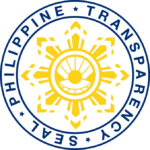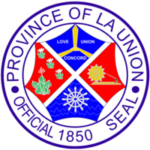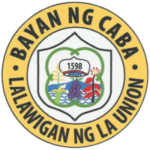
Caba was founded as a place of human abode in 1598. From 1598 to 1691, Caba was a settlement with Teniente Don Agustin dela Cruz as the first man to rule. From 1692 to 1738, Caba developed into a barangay or village with Teniente Don Luis Manongdo, indicted as “Ysu ti Ymmuna a tao a Cabesa” (Cabesa de Barangay), Teniente Don Luis Manongdo; he was the first man Cabesa or Cabesa de Barangay.
In 1739, Caba became a pueblo or town, simultaneously with Aringay, with Don Domingo Aragon as the Gobernadorcillo (Capitan Municipal). This historical account is gleaned from a church book in the Sta. Lucia Parish Church Archieve, Aringay, La Union, which is entitled Libro de los Bautismos y Cafsm del Pueblo de Aringay Caba x x x x ano de 1739 x x x.” Gobernadorcillo or Capitan Municipal (Municipal President) with Don Matias Runes assuming the title. From 1905 to 1907, Caba was made part of Aringay. Don Florencio Baltazar was the Presidente Municipal of Aringay at the time. By virtue of Executive Order No. 41, issued by Governador General James P. Smith, on October 25, 1907, Caba was separated from Aringay and became a regular town again.
How did Caba got its name?
History records that this municipality has three (3) names: CABA, CAVA and CAUA used interchangeably by chronicles through the years. According to Mr. Pedro Manongdo, local historian in his book “Diego Silang’s Birthplace”, It’s Exciting Past and Promising Present two tales have persisted on how Caba got its name.
First group ascribed it to an incident when a Spaniard asked a youth hired a herdsman the name of the place. The youth mistook the question for an inquiry as to the name of the anima he had been herding and his answer was VACA. Due probably to incorrect syllabication, VACA was changed to CAVA.
Second group sustains that Caba was the name given by some immigrant families of San Carlos, Pangasinan, who came to settle here sometime in the later years of the 16th century. In memory of the name of the barrio in San Carlos from where they came, they named the new settlement CABA.
The two traditions disagree diametrically against one another relative to correct and legitimate spelling of the name of the town. Researches had been conducted to resolve conclusively the controversy over the correct and legitimate name of the town and its spelling in order to do away with the long period of confusion the people had.
On the first tradition, it is noted that the answer to the query of the Spanish soldier – VACA- was a mistaken understanding of the youth as he mistook the inquiry of the Spanish soldier’s as to the name of the animal he was taking care of. Then, CAVA was another mistake. On the other hand, it is believed that the youth did not say VACA but BACA because there is no “v” in the Pilipino alphabet. The youth was a Filipino; the soldier was a Spaniard. VACA and CAVA are mistakes by themselves. The historicity of the name CAVA is absurd. On the second thought, had the youth correctly understood the query, he might have answered CABA.
The second tradition which sustains that C-A-B-A as the correct and legitimate name of this town, has historical basis. It makes it known that “Caba” was name given to this town by the first settlers who came from barrio Caba of San Carlos, now San Carlos City, in Pangasinan Province. In memory of the barrio from where they migrated, they named the place “CABA”
The three spellings of the name of the town can be read in records about the town – CABA, CAVA, CAUA. These different spellings –due partly to the system of writing in those early years – confuse a reader who might mistake them as three district towns when in fact they refer to only one and that is CABA. Diligent research, however, has established C-A-B-A as the correct and legitimate spelling of the name of the town.
CABA: Diego Silang’s Birth Place: Its Exciting Past and Promising Present:
The humble historical treatise entitled CABA: Diego Silang’s Birth Place, Its Exciting Past and Promising Present, is the product of intensive and extensive research on the history of Caba, a small town of La Union Province, from its founding as a place of human abode to the present. Ths contains chronological events and information about Caba portraying bright and dark aspects in its march since its inception as a small community to the present.
On December 16, 1730, a boy of Pangasinan parentage, was born in a village now called Caba, then within the northern part of Pangasinan Province. The boy grew up and became, in 1762, the Guiding Genius of the Iloko, One of the Heroes of Ilocandia, an able military leader of the Ilocos Revolt against the tyrannical and oppressive colonial government of Spain in the Philippines. An assassin’s bullet cut short his revolutionary career on May 28, 1763. But the Ilocos was for Independence did not stop with his death. His wife Dona Maria Josefa Gabriela, took the tork of leadership and continued the fight until her execution by hanging in Vigan, on September 20, 1763. Thus ended the Ilocos revolt of 1762-1763.
This boy was Diego Silang, considered one of the greatest Filipino patriots and heroes of the Philippines. He was called by historian “The guiding genius of the Iloko War of Independence.
During the incumbency of Honorable Epifanio B. Castillejos as Municipal Mayor in 1963, Diego Silang monument was erected at the town plaza. Since then, the town celebrated every 28th of May year after in commemoration of the Death Anniversary of the Ilokano Hero. The town plaza was adjudged as the Second Best Plaza in the Philippines. His election as Representative of the Second District and his subsequent membership to the cabinet as Director of the Domestic Trade accelerated further development of the municipality.
In 1968 until 1975, Honorable Agustin H. Valdez was elected as Municipal Mayor, the construction of the first Community Hospital and Health Center, now Caba Medicare and Community Hospital caters not only the people of Caba but to all neighboring towns in the province.
By 1986, after the EDSA uprising, Honorable. Edgar T. Bacungan appointed as the Acting Municipal Mayor and was elected and served as elected Mayor from 1988 to 1992. During his incumbency, when Oizumi Village, Kitakomagun, Yamanashi, Japan sister town of Caba was revived and send Agricultural Trainees to Japan for one-year agricultural study. It is during his term as Mayor when every December 16, the town celebrated Christmas Festival in commemoration of the birthday of Diego Silang.
Honorable Aurora P. Crispino was the First Elected Lady Mayor of Caba for three (3) consecutive terms in 1992 to June 30, 2001. She was a retired Division Supervisor of the Department of Education and Culture and the mother of former Mayor Clyde P. Crispino and the newly elected Municipal Mayor Philip Caesar P. Crispino. Through her inspiring leadership, the town hall was constructed, which was destroyed by the killer earthquake in 1990. More infrastructure projects have been established such as the DAR-ADB Project and other farm to market roads.
Second Lady Mayor, Honorable Agripina G. Estalilla, assumed in July 1, 2001 to February 24, 2006. She first run as Sangguniang Bayan Member Then Municipal Vice Mayor. Through her able leadership, as businesswoman by profession, more business establishments were set up through the construction of the public market and the Public Auditorium fence and other infrastructure projects. Five (5) years later, on February 24, 2006, Mayor Estalilla passed away and by rule of succession, Honorable Adoracion B. Runes, Municipal Vice Mayor took her oath of office as Municipal Mayor of the municipality.
Due to the rule of succession, first termer Sangguniang Bayan Member, Honorable Clyde P. Crispino assumed as Municipal Vice Mayor to the unexpired term of Vice Mayor Runes, due to the untimely death of Mayor Estalilla. Mayor Clyde P. Crispino was further elected and thus remains as Municipal Mayor up to June 30, 2016. Mayor Crispino, the youngest elected Municipal Mayor of the municipality of Caba finished his three (3) term as Municipal Mayor of Caba, La Union.
After the May 9, 2016 National and Local Elections, Honorable Philip Caesar Patacsil Crispino won unanimously as the Municipal Mayor of Caba, La Union, Mayor Philip as fondly called by his constituents is a Man of Action, is the younger brother of former Mayor Clyde P. Crispino, now the Municipal Vice Mayor.




